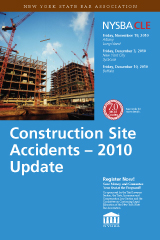In this New York Construction Accident case The Second Department granted plaintiff”s motion for summary judgment on his 240(1) cause of action. The facts as set forth by the Court were as follows;
“In August 2004 the plaintiff was working as a carpenter on a project involving renovation of office space for the lessee of that space, the defendant Orthopedic Associates of Dutchess County, P.C. (hereinafter the defendant). The plaintiff alleged that debris, including metal studs 10 to 12 feet long, were thrown down a chute from the fourth floor of the subject building, and that he was responsible for unclogging the bottom of the chute on the ground floor. He further alleged that he was injured when, while clearing the chute, he was struck on the hand and lower arm by one of those metal studs that had either been (a) deposited into the chute on the fourth floor and fell down the interior of the chute before striking him as he worked on the ground floor, (b) deposited into the chute on the fourth floor, and became blocked by a stud lodged near the bottom of the chute, but again began to fall when the plaintiff dislodged the lower stud, or (c) lodged near the bottom of the chute, but had become dislodged when another metal stud fell several stories down the interior of the chute and struck it.”
In granting the motion the Court citing Runner stated, ” The Court of Appeals has recently stated that “the single decisive question is whether plaintiff’s injuries were the direct consequence of a failure to provide adequate protection against a risk arising from a physically significant elevation differential” (Runner v New York Stock Exch., Inc., 13 NY3d at 603). The Court went on to state;
 New York Personal Injury Attorneys Blog
New York Personal Injury Attorneys Blog


 Ford pleaded with the Illinois Supreme Court Justices last week in hope that they’d overturn the $43 million Madison County verdict awarded to Dora Mae Jablonski in 2005, as reported in The Madison Record.
Ford pleaded with the Illinois Supreme Court Justices last week in hope that they’d overturn the $43 million Madison County verdict awarded to Dora Mae Jablonski in 2005, as reported in The Madison Record. The New York State Bar Association has chosen
The New York State Bar Association has chosen 
